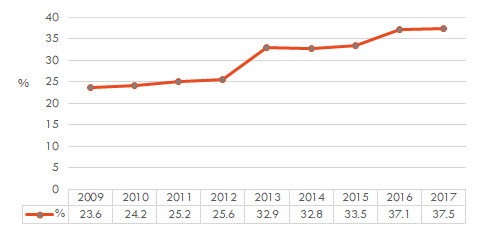
South Australia’s Aboriginal1 children and young people are vastly over-represented in in state care and in detention centres, according to the Productivity Commission’s Report on Government Services 2018 (ROGS 2018) and the trends are not positive.
The ROGS 2018 data on child protection showed that at 30 June 2017, Aboriginal children and young people comprised 33 per cent of all of those on care and protection orders and were 7.3 times as likely to be in out-of-home care as non-Aboriginal young people. In 2010-11 Aboriginal children and young people were 6.1 times as likely to be in care.The proportion of Aboriginal young people placed according to the Aboriginal Child Placement Principle (i.e. with kin, within their community or with Aboriginal families), has been declining in recent years from 76.4 per cent in 2009 to 62.5 per cent in 2017, below the national average of 67.6 per cent. (See the chart at the head of this story.)
Though comprising 33 per cent of children and young people in care, Aboriginal children and young people comprised 38 percent of the population in residential care.
The ROGS 2018 data on youth justice services showed that in 2015-16, 58 per cent of the population of 10-17 year olds in youth detention were Aboriginal and that proportion has been growing in recent years. South Australia had significantly higher rates of detention of Aboriginal children and young people than the Australian average. We present more data and charts about this subject from ROGS 2017 in the Guardian’s Snapshot of South Australian Aboriginal and Torres Strait Islander Children and Young People in Care and/or Youth Detention from the Report on Government Services 2016-17.Download the Snapshot of South Australian Aboriginal and Torres Strait Islander Children and Young People in Care and/or Youth Detention from the Report on Government Services 2016-17 now.
1 Aboriginal community preference in South Australia is that the term Aboriginal is inclusive of Torres Strait Islander people, a usage we generally adopt in our reports

